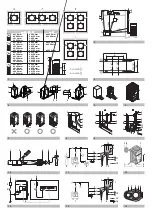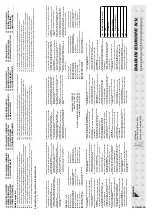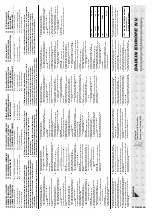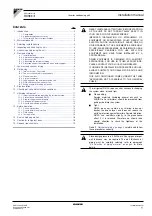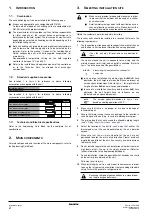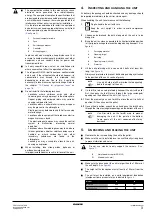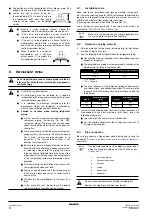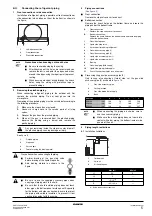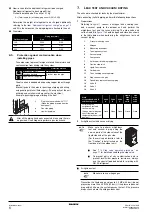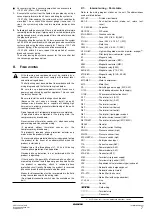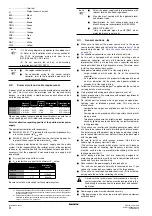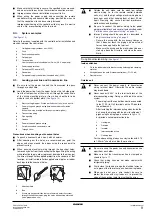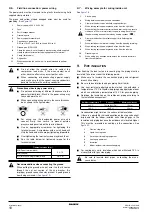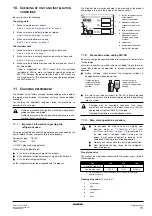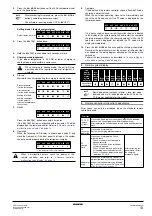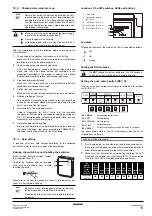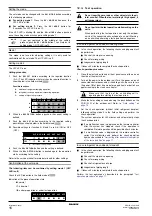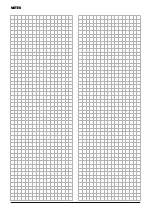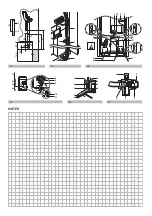
ERX125~250A7W1B
Inverter condensing unit
4PW30064-1D
Installation manual
11
10. C
HECKING
OF
UNIT
AND
INSTALLATION
CONDITIONS
Be sure to check the following:
The piping work
1
Make sure piping size is correct.
See
"6.2. Selection of piping material" on page 4
2
Make sure there is no faulty refrigerant piping.
See
"6. Refrigerant piping" on page 4
3
Make sure insulation work is done.
See
"9. Pipe insulation" on page 10
.
The electrical work
1
Make sure there is no faulty power wiring or loose nuts.
See
2
Make sure there is no faulty transmission wiring or loose nuts.
See
3
Make sure the insulation resistance of the main power circuit is
not deteriorated.
Using a megatester for 500
V, check that the insulation
resistance of 2 M
Ω
or more is attained by applying a voltage of
500 V DC between the power terminals and earth. Never use
the megatester for the transmission wiring (between outdoor
and control box, etc.).
11. C
HARGING
REFRIGERANT
The outdoor unit is factory charged, but depending on the length of
the piping when installed, the outdoor unit may require additional
charging.
For charging the additional refrigerant follow the procedure as
described in this chapter.
11.1. Important information regarding the
refrigerant used
This product contains fluorinated greenhouse gases covered by the
Kyoto Protocol. Do not vent gases into the atmosphere.
Refrigerant type:
R410A
GWP
(1)
value:
1975
(1)
GWP = global warming potential
Please fill in with indelible ink,
■
➀
the factory refrigerant charge of the product,
■
➁
the additional refrigerant amount charged in the field and
■
➀
+
➁
the total refrigerant charge
on the refrigerant charge label supplied with the product.
The filled out label must be adhered in the proximity of the product
charging port (e.g. onto the inside of the service cover).
11.2. Precautions when adding R410A
Be sure to charge the specified amount of refrigerant in liquid state to
the liquid pipe.
Since this refrigerant is a mixed refrigerant, adding it in gas form may
cause the refrigerant composition to change, preventing normal
operation.
■
Before charging, check whether the refrigerant cylinder is
equipped with a siphon tube or not.
■
Be sure to use tools exclusively for R410A to ensure required
pressure resistance and to prevent foreign materials from mixing
into the system.
11.3. Stop valve operation procedure
Size of stop valve
The sizes of the stop valves connected to the system are as listed in
the table below.
Opening stop valve
Refrigerant cannot be charged until all field wiring and field
piping has been completed.
Refrigerant may only be charged after performing the leak
test and the vacuum drying.
Charge the liquid
refrigerant with the
cylinder in upright
position.
Charge the liquid
refrigerant with the
cylinder in up-side-down
position.
Charging with an unsuitable substance may cause
explosions and accidents, so always make sure that the
appropriate refrigerant (R410A) is charged.
Refrigerant containers must be opened slowly.
■
Do not open the stop valve until all piping and
electrical steps of
installation conditions" on page 11
the stop valve is left open without turning on the
power, it may cause refrigerant to build up in the
compressor, leading to insulation degradation.
■
Always use a charge hose for service port connection.
■
After tightening the cap, check that no refrigerant
leaks are present.
Type
125
200
250
Liquid line stop valve
Ø9.5
Gas line stop valve
Ø15.9
Ø19.1
Ø25.4
(a)
(a) The model ERX250 supports field piping of Ø22.2 on the accessory pipe
supplied with the unit.
1
Service port
2
Cap
3
Hexagon hole
4
Shaft
5
Seal
3
5
6
2
1
4
1
factory refrigerant charge
of the product:
see unit name plate
2
additional refrigerant
amount charged in the
field
3
total refrigerant charge
4
Contains fluorinated
greenhouse gases
covered by the Kyoto
Protocol
5
outdoor unit
6
refrigerant cylinder and
manifold for charging


